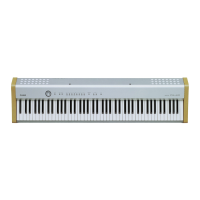
Do you have a question about the Casio PS-20 and is the answer not in the manual?
| Brand | Casio |
|---|---|
| Model | PS-20 |
| Category | Electronic Keyboard |
| Language | English |
Explains symbols used in the guide for safe and correct product use.
Illustrates caution and prohibition symbols with their meanings.
Describes the piano's aesthetic and integration into any interior layout.
Details instrument tones, digital effects, and sound quality adjustments.
Highlights the metronome and demo tunes for learning and practice.
Covers memory recording, MIDI connectivity, and keyboard setting functions.
Details connections and controls located on the rear panel of the digital piano.
Details connections and controls located on the left side panel of the digital piano.
Introduces the concept of connecting external audio or musical equipment.
How to connect headphones for private practice without disturbing others.
Connecting damper and soft/sostenuto pedals for enhanced playability.
Linking the digital piano to external audio systems for amplified sound.
Connecting to amplifiers for louder sound output.
Guidance on using authorized accessories and optional items with the piano.
Instructions and important precautions for using the AC power adapter.
How to choose and play different instrument sounds, including polyphony and touch response.
Applying reverb and chorus effects to enhance sound characteristics.
Settings for speaker and headphone sound profiles for optimal listening.
Details on damper, soft, and sostenuto pedal functions and their operation.
How to use and adjust the metronome for practice sessions and beat timing.
How to record keyboard play, tone settings, and pedal operations into memory.
How to play back recorded data from memory and toggle the playback metronome.
Procedure to erase recorded data from memory, with important warnings.
How to play all built-in demo tunes one after another.
How to select and play a single demo tune repeatedly.
How to stop the demo tune playback using the DEMO or START/STOP button.
Adjusting keyboard sensitivity to playing style, from light to heavy touch.
Changing the pitch of the digital piano in semitone steps.
Fine-tuning the piano's pitch to play along with other instruments.
Introduction to Musical Instrument Digital Interface standard and its purpose.
Sending and receiving MIDI data between the piano and other devices.
Connecting MIDI cables to other musical instruments or computers.
Understanding MIDI channel communication and multi-timbre capabilities.
Assigning built-in tones to MIDI channels for multi-track sequencing.
Setting the MIDI channel for sending keyboard performance data.
Transmitting recorded performance data via MIDI.
Managing keyboard and pedal connection to the digital piano's sound source.
Details on MIDI data, program changes, and pedal/effect operation data.